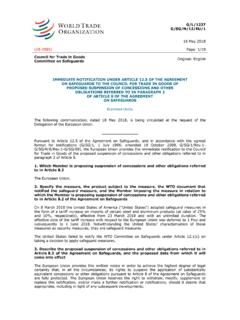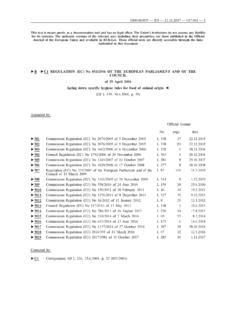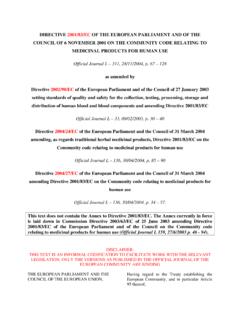Transcription of Frequently Asked Questions on Directive 2006/66/EU on ...
1 commission Services document - not legally binding european commission . DIRECTORATE-GENERAL. ENVIRONMENT. Frequently Asked Questions on Directive 2006/66/EU on Batteries and Accumulators and Waste Batteries and Accumulators (Updated version, May 2014). commission Services document - not legally binding Foreword This Frequently Asked Questions (FAQ) document on Directive 2006/66/EC on batteries and accumulators and waste batteries and accumulators updates and replaces an earlier version of the document. It takes account of a number of amendments to the Directive including those agreed under Directive 2013/56/EU, which entered into force on 30 December 2013 and which Member States are required to transpose into national law by 1 July 2015. The document is principally intended to help competent public authorities and economic operators interpret the provisions of the Directive in order to ensure compliance with the Directive 's requirements.
2 However, the Directive being addressed only to the Member States, the rights and obligations for private parties exclusively flow from the measures enacted by the authorities of the Member States to implement it. This FAQ document is considered to be a living document' and the commission may update it as necessary in light of the experience with the implementation of the Directive and any future requirements. Finally, as is customary, this FAQ document reflects the views of DG Environment and as such is not legally binding. Binding interpretation of EU legislation is the exclusive competence of the Court of Justice of the european Union. 2. commission Services document - not legally binding Questions AND ANSWERS. ON THE. BATTERIES Directive (2006/66/EC)1. TABLE OF CONTENTS. 1. Directive 2006/66/EC- HISTORY.
3 6. Directive 2006/66/EC replaced Directive 91/157/EEC on batteries why did the old version need to be amended? .. 6. Have any changes been made to the Directive since its entry to force?..6. Why does the Directive apply to all batteries and not just to hazardous ones? 6. 2. CONTENT OF Directive 2006/66/EC .. 7. Objective .. 7. What does the Directive aim to achieve? .. 7. What environmental problems does the Directive address? .. 7. How are these environmental problems addressed? .. 7. What is the problem concerning the single european market? .. 8. How does the Directive address this market problem? .. 8. Scope .. 9. What is the scope of Directive 2006/66/EC? .. 9. Are specific fuel-cells, classical capacitors and super-capacitors covered by the Directive ? .. 9. Are sealed batteries covered by the Directive ?
4 9. Preventive measures .. 9. What are the preventive measures in the Directive ? .. 9. Collection .. 10. What are the requirements for collecting batteries? .. 10. What are the collection targets for portable batteries? .. 11. How are the collection targets for portable batteries monitored? .. 11. Why is there no collection target for industrial and automotive batteries? .. 11. Recycling .. 11. Why should we recycle batteries? .. 11. 1. OJ L 266, , p. 1. 3. commission Services document - not legally binding What examples are there of energy saved by using recycled metals in batteries?.. 12. What recycling requirements are laid down in the Directive ? .. 12. What recycling efficiency levels are laid down in the Directive ? .. 12. Does the Directive lay down any requirements for treatment of waste batteries?
5 12. Financing and producer responsibility .. 13. Who will pay for the collection, treatment and recycling of batteries? .. 13. What is the difference between third parties' and third parties acting on behalf of producers'? .. 13. What is the definition of battery producer'? .. 13. Who is the battery producer'? - Examples .. 13. How does the Directive deal with small producers? .. 14. How does the Directive deal with the free rider' problem? .. 15. Labels/End-user information .. 15. What labelling requirements apply to batteries? .. 15. How should batteries be marked with a chemical symbol? .. 16. What capacity labelling rules apply to portable and automotive batteries? .. 16. What will be done to address the absence of harmonised EU rules on capacity labelling for portable non-rechargeable batteries?
6 17. How will end-users know what to do with waste batteries? .. 17. Who is responsible for informing the public? .. 18. Removing batteries from appliances .. 18. Which appliances are covered by the Directive 's Article 11 concerning the removal of waste batteries and accumulators? .. 18. What does the Directive say about making sure that waste batteries can be removed from appliances?.. 18. When should waste batteries and accumulators be removable from appliances? .. 19. Exporting waste batteries .. 19. What requirements must be met if batteries are exported for recycling? .. 19. Implementing the Directive .. 19. When do EU Member States have to transpose the requirements of this Directive ? .. 19. Can the Directive be transposed on the basis of environmental agreements with industry? .. 19. What is the deadline for achieving collection targets for portable batteries?
7 19. 4. commission Services document - not legally binding When do the recycling requirements come into force? .. 20. Are national governments encouraged to use financial incentives to implement the Directive ? .. 20. Are national governments obliged to report on the implementation of the Directive ? .. 20. 3. SUMMARY OF THE MEASURES IN THE Directive ACCORDING TO. BATTERY TYPE .. 20. What are the different types of batteries? .. 20. Do batteries used for agricultural purposes qualify as industrial batteries? .. 21. Are batteries used in hybrid vehicles (vehicles that run on a combination of fuel and electricity) automotive or industrial batteries? .. 21. Which batteries are the most harmful? .. 22. What specific rules apply to portable batteries and accumulators? .. 22. What specific rules apply to industrial batteries?
8 22. What specific rules apply to automotive batteries? .. 23. 4. LINK WITH OTHER PIECES OF 23. What is the relationship between the Batteries Directive and other EU. legislation? .. 23. What is the relationship between the Batteries Directive and the ELV. Directive ? .. 23. What is the relationship between the Batteries Directive and the RoHS. Directive ? .. 25. Which Directive applies to the outer casings of battery packs? Is it the RoHS or the Batteries Directive ? .. 25. What is the relationship between the Batteries Directive and the WEEE. Directive ? .. 25. Do the requirements set out in Article 11 of the Batteries Directive apply to batteries incorporated in infected medical devices? .. 26. Do the requirements set out in Article 11 of the Batteries Directive apply to batteries incorporated in toys and musical post cards?
9 27. 5. commission Services document - not legally binding 1. Directive 2006/66/EC- HISTORY. Directive 2006/66/EC replaced Directive 91/157/EEC on batteries why did the old version need to be amended? Previous EU legislation on batteries ( Directive 91/157/EEC) failed to adequately address the risks posed by waste batteries and to create a uniform system for collecting and recycling batteries. For example, in 2002, more than 45 % of all portable batteries sold in the EU ( 72 155. tonnes) went for landfilling or Waste batteries collected were disposed of in this way instead of being Moreover, the EU needed a uniform system for collecting and recycling batteries, and in particular for financing these operations, to avoid free-riders' on the market and to create a level playing field for everyone involved.
10 Have any changes been made to Directive 2006/66/EC since its entry to force? Yes. To date the Directive has been amended three times. In 2008, it was modified twice as regards the implementing powers conferred on the commission and as regards placing batteries and accumulators on the market4. In 20135, it was amended to remove exemptions regarding the use of cadmium in portable batteries used in cordless power tools (article ) and with respect to the use of mercury in button cells (article ). At the same time changes were made to some other provisions of the Directive , in particular placing on the market (article ) and the removability of batteries (article 11). Furthermore, the procedural requirements for the registration of producers (laid down in commission Decision 2009/603/EC) were incorporated in a new Annex IV of the Directive and Decision 2009/603/EC will be repealed upon with effect from 1 July 2015.

















